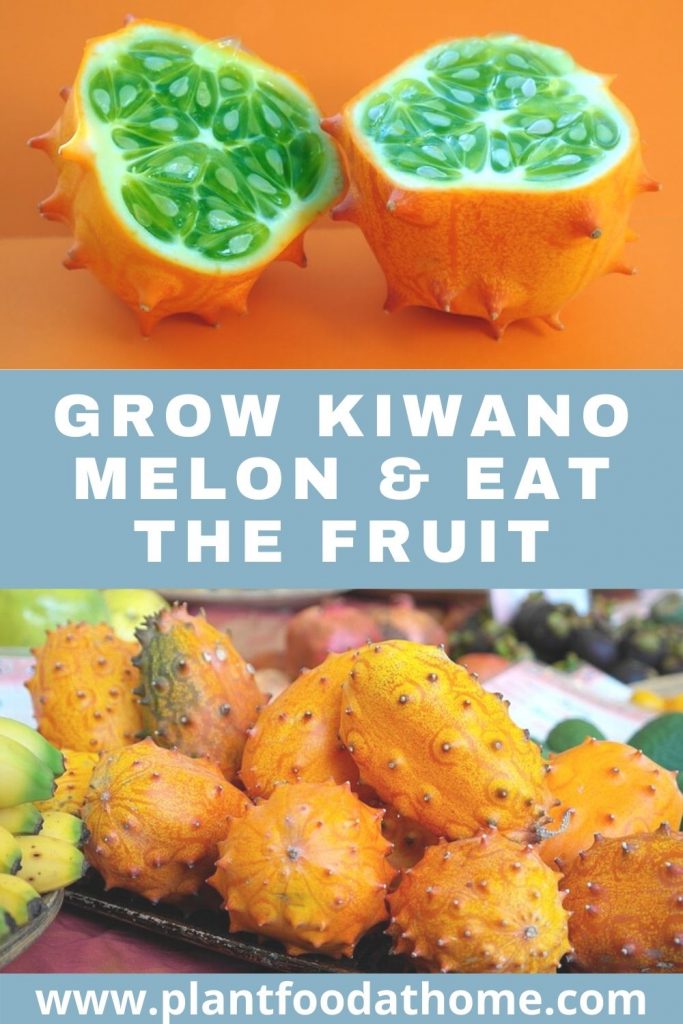While you may not always find the kiwano melon in your local grocery store, perceptive fans of recent blockbuster movies may recognize this strange-looking fruit. It makes cameos in Avengers: Endgame, Star Wars: The Force Awakens. It is also featured prominently in an episode of Star Trek: Deep Space Nine. Kiwano melon’s unique external appearance has led to it being type-cast as some sort of sci-fi space fruit, but it is very possible to grow and enjoy here on planet Earth. So let’s dig into how to grow kiwano melon and how to eat the fruit.
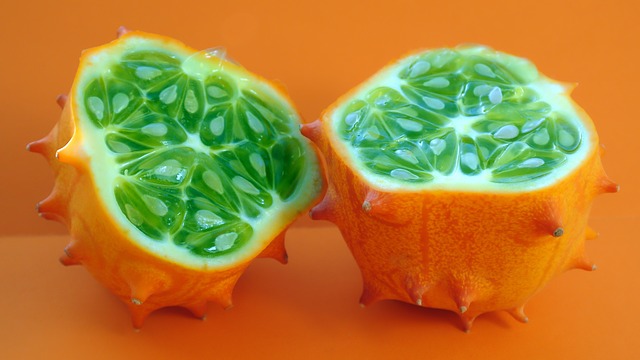
Table of Contents
- Kiwano Melon Plant Profile
- Ideal Growing Conditions for Kiwano Melon
- How to Grow Kiwano Melon From Seed
- Kiwano Melon Plant Pollination
- Dealing with Pests and Disease
- Harvesting and Storing Kiwano Melon
- What Does Kiwano Melon Taste Like
- How to Eat a Kiwano Melon
- Nutritional Information and Health Benefits of Kiwano Fruit
- Conclusion
- Some Favorite Gardening Products
Kiwano Melon Plant Profile
The Kiwano melon fruit has bright yellow or orange skin when ripe with prominent spikes. This feature gives rise to its other popular name; the African Horned Melon. It also goes by simply horned melon, spiked melon, cuke-asaurus, or jelly melon.
A full-grown kiwano melon fruit is approximately the size of an avocado. Cutting one open reveals a bright green jelly-like flesh which only adds to the out-of-this-world visual. However, the Kiwano is very much of this world, having originated from Southern Africa, and today can be found growing commercially in as widespread locales as New Zealand and the United States.
The plant itself, Cucumis metuliferus, is a relative of the cucumber and shares many similarities. It is an annual plant and grows as a sprawling, spreading vine similar to other melons.
Kiwano melons grow upwards of ten feet (3 meters) in multiple directions. One gardener estimated a whopping 100 feet (30 meters). If you can imagine a large pumpkin patch then you have an idea of how big kiwano melon vines can grow and spread. On the upside to this, you can expect around 100 kiwano melon fruits from one plant.
The leaves are broad, heart-shaped, and dark green. Tendrils are sent out, wrapping themselves around anything that might offer support such as strong trellises and fences.
In the wild, kiwano melon plants have been known to intertwine with bushes and around trees so consider your planting location based on what you may have around the area.
Ideal Growing Conditions for Kiwano Melon
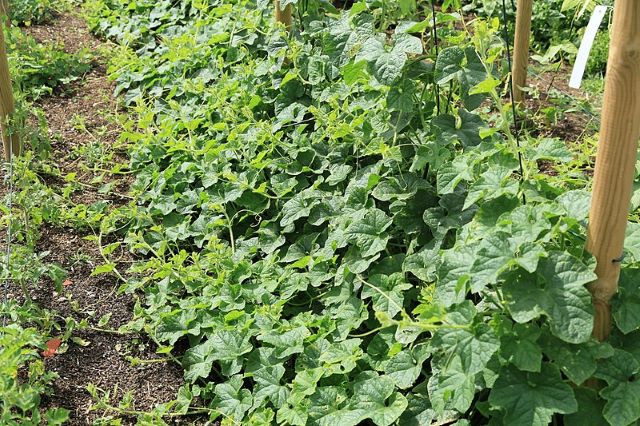
Since the kiwano comes to us from Sub-Saharan Africa, its ideal growing conditions are generally hot and dry. This arid climate includes full sun and a temperature range between 68 and 95 degrees Fahrenheit (20-35°C.).
The soil should be well-draining and loamy and a pH of 6-6.5 is ideal for this plant. The kiwano plant will also benefit from the addition of organic matter to the soil such as compost and well-rotted manure.
A good, deep, weekly watering of 1-2 inches is sufficient for mature kiwano melon plants, and you can allow the soil to dry somewhat between waterings.
With these conditions, the kiwano melons shouldn’t need much in the way of fertilizing. A seaweed solution is a good, natural fertilizer as well as a top-up of homemade compost during the growing season.
How to Grow Kiwano Melon From Seed
Direct seed sowing should occur only after all danger of frost has passed and once the temperature is consistently 68°F (20°C) or above.
Seeds should be planted in groups of two to three at a depth of approximately 1 inch.
Space plants at least 35 inches (90 cm) apart. It’s a good idea to include a strong trellis or other climbing support at this time, so new seedlings will have something to climb once they sprout.
Be sure to water the soil well after planting new kiwano melon seeds. Then keep the soil lightly moist until germination occurs in approximately two to three weeks. Be aware that temperatures below 68°F (20°C) will delay germination.
Starting kiwano melon seeds indoors is also an option. This can be done 4-6 weeks prior to the last expected frost date. Then seedlings with two true leaves can be planted in the garden once the temperature has warmed up. You might like to see our article How to Start Vegetable Seedlings Under Grow Lights.
Kiwano Melon Plant Pollination
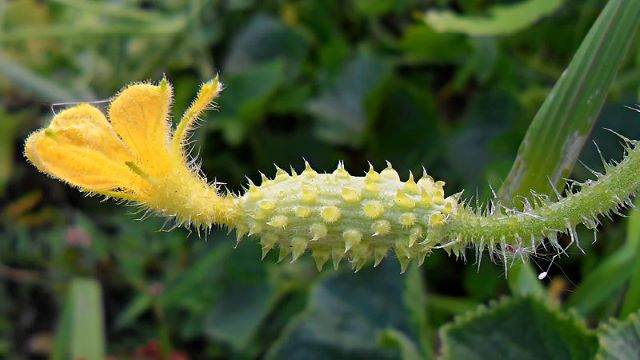
The Kiwano is a monoecious plant meaning the same stem produces male and female flowers. Male flowers appear first, followed by female flowers. Male flowers grow in small clumps at the end of a long stem. Female flowers grow as individual blooms. You will find the small, immature fruit at the base of the female flower.
The yellow flowers attract natural pollinators such as bees and other insects. And you can increase the success of natural pollination by planting insect-loving flowers around your garden. You could try planting nasturtiums nearby.
If you like, you can increase pollination by hand pollinating which is not as complicated as it perhaps sounds. To hand-pollinate, take a small paintbrush and gently brush the inside of the male flowers to collect the pollen. Then brush the pollen on the inside of the female flower.
Dealing with Pests and Disease
One upside of growing kiwano melons is the high resistance to disease.
Kiwano melon is generally resistant to powdery mildew however, if it does occur, here is a DIY milk spray that should take care of the problem.
The horned melon can be sensitive to the Squash mosaic virus (or smv). This is a widespread disease that afflicts many species of squash and melon.
Young plants exhibit heavily mottled or cupping of the leaves, but the disease can be more difficult to identify in older plants until the fruit shows signs of the same mottling.
Squash mosaic virus is transmitted by various kinds of beetles. Row covers are the best way to prevent an infestation naturally. Smv is also seed-borne meaning once a kiwano plant is infected, the only way to eliminate the disease is to destroy the plant. This is unfortunate, but necessary to prevent the spread of the virus to future plants.
Harvesting and Storing Kiwano Melon
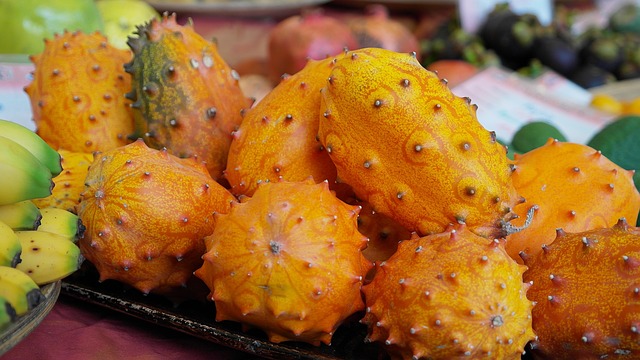
The growing time from seed to harvest for the kiwano melon is approximately four months in warm weather. From the time new fruit is spotted until it is ripe for harvest is somewhere between thirty and forty days.
Ripening occurs when the kiwano fruit turns from green to its trademark golden yellow or orange. It is also possible to ripen the fruit off the vine, however, the fruit should begin turning color before being picked for this option.
When harvesting kiwano melon fruit, care should be taken around the kiwano melon vine due to its prickly nature. You may want to wear gloves because the vines and the fruit can be prickly. Using garden clippers or scissors, cut the fruit off the stem to harvest the horned melon fruit.
Kiwano melons, with their blunt spikes, should not be stacked on top of each other, since they can easily puncture the skin of other kiwano fruits. Broken spikes can also bleed a dark red liquid so be careful where you put them to prevent staining.
Kiwano has an amazing shelf life when kept in the right conditions, and these conditions are not difficult to obtain. These melons can last as long as six months at room temperature. This longevity means they can be used as decoration as well as a food source. Place them on the kitchen counter or in your fruit bowl to add some color and interest. Do not refrigerate.
What Does Kiwano Melon Taste Like
The taste of a kiwano melon is a fresh mildly sweet cucumber with hints of banana and the slight tanginess of lime. Kiwi and passionfruit are other flavors often used to describe the taste of kiwano melon.
When you cut into a kiwano melon, you will immediately notice the striking green color, an abundance of seeds, and jelly-like texture. It hardly resembles other more widely known melons such as watermelon or cantaloupe. Instead, it is more of a jelly-like consistency similar to the inside of aloe vera but with seeds.
How to Eat a Kiwano Melon
Because of the mild fruit flavor, the kiwano has a wide range of uses in the kitchen, beginning with eating the fruit itself. The skin is edible but rarely eaten.
To eat raw, cut the kiwano melon in half. From there you can simply scoop out the flesh with a spoon and eat it. Or you can squeeze or scoop the pulp into a dish.
The seeds are small and slim, making them easy to eat. They are similar to seeds found in regular cucumbers but some people choose to suck the pulp off and discard the seeds.
The kiwano is a wonderful candidate for most traditional fruit recipes. Add it to your smoothie or breakfast bowl in the morning. Put it over ice cream or yogurt for a refreshing touch to dessert. If you own a juicer, try adding it to your current blend of fruits and vegetables.
It is also a wonderful topping in many savory recipes, adding a sweet, tropical flare. Try it in a fresh spring or summer-themed salad. Put it out as an option for your next Taco Tuesday. Looking for a unique take on salsa? Kiwano can take the place of fruits such as pineapple or mango.
With grilling season upon us, Kiwano pairs nicely with the flavors of grilled seafood and chicken.
Use the kiwano melon to flavor water for a refreshing change to regular water.
The bright green color also makes it a fun ingredient for holidays and themed events. Adding the kiwano to food and drink is a great way to achieve that perfect St. Patrick’s Day green. The sliminess (is that a word?) adds that wonderful “eew” factor to a children’s Halloween celebration.
Nutritional Information and Health Benefits of Kiwano Fruit
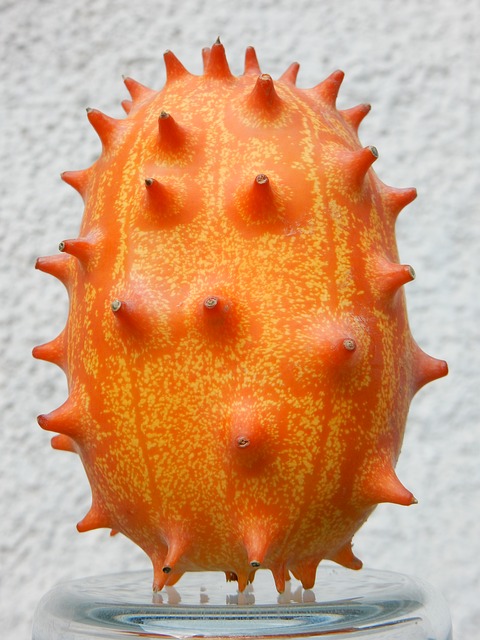
The kiwano has many benefits that the health-conscious person will find appealing. The original health benefit of the melon, as it grew in the desert heat of Africa, was hydration.
After all, it is 89 percent water and so became essential to surviving the dry months. This is still beneficial today by providing nutrient-rich hydration with naturally occurring electrolytes.
Some of the essential vitamins and nutrients provided by the horned fruit are magnesium, potassium, iron and vitamin C.
Additionally, the Kiwano melon provides 3 grams of fiber and 3.7 grams of protein. Both being essential nutrients many of us have difficulty getting enough of on a daily basis.
Adding kiwano can also be helpful for those who are dieting for weight loss. Its high water content makes it a filling snack option while being low in calories. It has approximately 36 cals per 100 grams which is about half a melon.
It is also lower in sugar than many other fruits. All fruits contain some naturally occurring sugars making them somewhat of a paradox for many weight-loss diets. The kiwano has just 3.8 grams of sugar per 100 grams which is significantly less than many common fruits such as apples and oranges. The banana for example has 12 grams. It is even lower than other fruits with high water content like watermelon.
These characteristics can help in getting the necessary nutrients and curbing hunger while dieting.
Conclusion
The low maintenance and wide variety of uses make the kiwano melon an ideal candidate for home gardens. Its out-of-this-world physical features will add a touch of intrigue to your backyard and be a great topic of conversation when entertaining. The shelf life alone is a compelling reason to consider adding this unique fruit when planning out next season’s garden. Why not give it a try?
Some Favorite Gardening Products
- AeroGarden Bounty Indoor Hydroponic Herb Garden
- Felco Garden Pruners
- King Bird Raised Garden Bed
- Sloggers Waterproof Garden Gum Boots
- Horticultural Neem Oil
Further reading:
- Pepino Melon: How To Grow The Plant And Eat The Fruit
- Growing Cucamelons: Planting, Caring and Harvesting Cucamelon
- How to Grow Watermelons: Planting, Caring and Harvesting Watermelons
- Watermelon Plant Dying? Causes and Solutions
- How to Grow Cucumbers: Planting, Growing and Harvesting
- 7 Reasons Why Your Cucumbers Are Turning Yellow
- A Guide to Harvesting Ripe Cantaloupes
